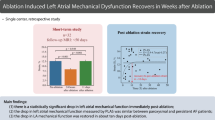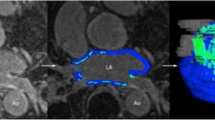Abstract
Dissipative energy loss (EL), an index of inefficient blood flow, has not been studied in patients with atrial fibrillation (AF). We therefore assessed the effect of AF and of successful catheter ablation on left ventricular (LV) EL and global longitudinal strain (GLS) to explore the effect of inefficient blood flow on LV remodeling. In 53 patients undergoing catheter ablation for AF (AF group), LV EL (in mW/m) was evaluated by vector flow mapping (VFM) during systole (ELsys), early diastole (ELed) and atrial contraction phase (ELac), and GLS was calculated by two-dimensional tissue tracking (2DTT). Of the 53 patients, 37 patients who sustained sinus rhythm and completed echocardiographic evaluation at baseline and at 3 and 6 months follow-up were examined for change in EL and GLS. The latter parameters also were assessed in 44 age- and sex-matched controls. At baseline in AF group, ELsys and ELed were significantly higher (3.97 ± 2.29 vs. 3.14 ± 1.01; and 9.22 ± 5.01 vs. 3.89 ± 1.51; both P < 0.05, respectively), and GLS was lower (− 16.66 ± 3.50 vs. − 19.95 ± 2.40, P < 0.05) than in controls. During follow-up after catheter ablation, ELsys and ELed significantly improved at 3 months, and almost normalized at 6 months (both P < 0.05); GLS also improved significantly (P < 0.05). In multivariate logistic regression analysis, ELed was the only independent predictor for maintenance of sinus rhythm at 1-year follow-up (hazard ratio, 1.254; 95% confidence interval 1.073–1.467). VFM and 2DTT revealed impaired LV EL and GLS in patients with AF. Successful catheter ablation appeared to ameliorate impairment in intraventricular flow and mechanics.



Similar content being viewed by others
References
Kirchhof P, Benussi S, Kotecha D, Ahlsson A, Atar D, Casadei B, Castella M, Diener HC, Heidbuchel H, Hendriks J, Hindricks G, Manolis AS, Oldgren J, Popescu BA, Schotten U, Van Putte B, Vardas P, Agewall S, Camm J, Baron Esquivias G, Budts W, Carerj S, Casselman F, Coca A, De Caterina R, Deftereos S, Dobrev D, Ferro JM, Filippatos G, Fitzsimons D, Gorenek B, Guenoun M, Hohnloser SH, Kolh P, Lip GY, Manolis A, McMurray J, Ponikowski P, Rosenhek R, Ruschitzka F, Savelieva I, Sharma S, Suwalski P, Tamargo JL, Taylor CJ, Van Gelder IC, Voors AA, Windecker S, Zamorano JL, Zeppenfeld K (2016) 2016 ESC Guidelines for the management of atrial fibrillation developed in collaboration with EACTS. Europace 18(11):1609–1678. https://doi.org/10.1093/europace/euw295
Bunch TJ, Crandall BG, Weiss JP, May HT, Bair TL, Osborn JS, Anderson JL, Muhlestein JB, Horne BD, Lappe DL, Day JD (2011) Patients treated with catheter ablation for atrial fibrillation have long-term rates of death, stroke, and dementia similar to patients without atrial fibrillation. J Cardiovasc Electrophysiol 22(8):839–845. https://doi.org/10.1111/j.1540-8167.2011.02035.x
Pedrizzetti G, La Canna G, Alfieri O, Tonti G (2014) The vortex—an early predictor of cardiovascular outcome? Nat Rev Cardiol 11(9):545–553. https://doi.org/10.1038/nrcardio.2014.75
Kilner PJ, Yang GZ, Wilkes AJ, Mohiaddin RH, Firmin DN, Yacoub MH (2000) Asymmetric redirection of flow through the heart. Nature 404(6779):759–761. https://doi.org/10.1038/35008075
Stugaard M, Koriyama H, Katsuki K, Masuda K, Asanuma T, Takeda Y, Sakata Y, Itatani K, Nakatani S (2015) Energy loss in the left ventricle obtained by vector flow mapping as a new quantitative measure of severity of aortic regurgitation: a combined experimental and clinical study. Eur Heart J Cardiovasc Imaging 16(7):723–730. https://doi.org/10.1093/ehjci/jev035
Itatani K, Okada T, Uejima T, Tanaka T, Ono M, Miyaji K, Takenaka K (2013) intraventricular flow velocity vector visualization based on the continuity equation and measurements of vorticity and wall shear stress. Jpn J Appl Phys 52(7S):07HF16. https://doi.org/10.7567/jjap.52.07hf16
Tops LF, Den Uijl DW, Delgado V, Marsan NA, Zeppenfeld K, Holman E, van der Wall EE, Schalij MJ, Bax JJ (2009) Long-term improvement in left ventricular strain after successful catheter ablation for atrial fibrillation in patients with preserved left ventricular systolic function. Circ Arrhythm Electrophysiol 2(3):249–257. https://doi.org/10.1161/CIRCEP.108.838748
Kim IS, Kim TH, Shim CY, Mun HS, Uhm JS, Joung B, Hong GR, Lee MH, Pak HN (2015) The ratio of early transmitral flow velocity (E) to early mitral annular velocity (Em) predicts improvement in left ventricular systolic and diastolic function 1 year after catheter ablation for atrial fibrillation. Europace 17(7):1051–1058. https://doi.org/10.1093/europace/euu346
Lang RM, Badano LP, Mor-Avi V, Afilalo J, Armstrong A, Ernande L, Flachskampf FA, Foster E, Goldstein SA, Kuznetsova T, Lancellotti P, Muraru D, Picard MH, Rietzschel ER, Rudski L, Spencer KT, Tsang W, Voigt JU (2015) Recommendations for cardiac chamber quantification by echocardiography in adults: an update from the American Society of Echocardiography and the European Association of Cardiovascular Imaging. J Am Soc Echocardiogr 28(1):1 e14–39 e14. https://doi.org/10.1016/j.echo.2014.10.003
Anselmino M, Matta M, D’Ascenzo F, Bunch TJ, Schilling RJ, Hunter RJ, Pappone C, Neumann T, Noelker G, Fiala M, Bertaglia E, Frontera A, Duncan E, Nalliah C, Jais P, Weerasooriya R, Kalman JM, Gaita F (2014) Catheter ablation of atrial fibrillation in patients with left ventricular systolic dysfunction: a systematic review and meta-analysis. Circ Arrhythm Electrophysiol 7(6):1011–1018. https://doi.org/10.1161/CIRCEP.114.001938
Zhu P, Zhang Y, Jiang P, Wang Z, Wang J, Yin X, Hou Y (2014) Effects of radiofrequency catheter ablation on left ventricular structure and function in patients with atrial fibrillation: a meta-analysis. J Interv Card Electrophysiol 40(2):137–145. https://doi.org/10.1007/s10840-014-9903-1
Lutomsky BA, Rostock T, Koops A, Steven D, Mullerleile K, Servatius H, Drewitz I, Ueberschar D, Plagemann T, Ventura R, Meinertz T, Willems S (2008) Catheter ablation of paroxysmal atrial fibrillation improves cardiac function: a prospective study on the impact of atrial fibrillation ablation on left ventricular function assessed by magnetic resonance imaging. Europace 10(5):593–599. https://doi.org/10.1093/europace/eun076
Elbaz MS, van der Geest RJ, Calkoen EE, de Roos A, Lelieveldt BP, Roest AA, Westenberg JJ (2017) Assessment of viscous energy loss and the association with three-dimensional vortex ring formation in left ventricular inflow: in vivo evaluation using four-dimensional flow MRI. Magn Reson Med 77(2):794–805. https://doi.org/10.1002/mrm.26129
Akiyama K, Maeda S, Matsuyama T, Kainuma A, Ishii M, Naito Y, Kinoshita M, Hamaoka S, Kato H, Nakajima Y, Nakamura N, Itatani K, Sawa T (2017) Vector flow mapping analysis of left ventricular energetic performance in healthy adult volunteers. BMC Cardiovasc Disord 17(1):21. https://doi.org/10.1186/s12872-016-0444-7
Hayashi T, Itatani K, Inuzuka R, Shimizu N, Shindo T, Hirata Y, Miyaji K (2015) Dissipative energy loss within the left ventricle detected by vector flow mapping in children: normal values and effects of age and heart rate. J Cardiol 66(5):403–410. https://doi.org/10.1016/j.jjcc.2014.12.012
Kheradvar A, Assadi R, Falahatpisheh A, Sengupta PP (2012) Assessment of transmitral vortex formation in patients with diastolic dysfunction. J Am Soc Echocardiogr 25(2):220–227. https://doi.org/10.1016/j.echo.2011.10.003
Li CM, Bai WJ, Liu YT, Tang H, Rao L (2017) Dissipative energy loss within the left ventricle detected by vector flow mapping in diabetic patients with controlled and uncontrolled blood glucose levels. Int J Cardiovasc Imaging 33(8):1151–1158. https://doi.org/10.1007/s10554-017-1100-8
Zhong Y, Liu Y, Wu T, Song H, Chen Z, Zhu W, Cai Y, Zhang W, Bai W, Tang H, Rao L (2016) Assessment of left ventricular dissipative energy loss by vector flow mapping in patients with end-stage renal disease. J Ultrasound Med 35(5):965–973. https://doi.org/10.7863/ultra.15.06009
Seo JH, Mittal R (2013) Effect of diastolic flow patterns on the function of the left ventricle. Phys Fluids 25(11):110801. https://doi.org/10.1063/1.4819067
Miwa H, Arakawa M, Kagawa K, Noda T, Nishigaki K, Ito Y, Kawada T, Hirakawa S (1993) Time-course of recovery of atrial contraction after cardioversion of chronic atrial fibrillation. Heart Vessels 8(2):98–106
Reant P, Lafitte S, Jais P, Serri K, Weerasooriya R, Hocini M, Pillois X, Clementy J, Haissaguerre M, Roudaut R (2005) Reverse remodeling of the left cardiac chambers after catheter ablation after 1 year in a series of patients with isolated atrial fibrillation. Circulation 112(19):2896–2903. https://doi.org/10.1161/CIRCULATIONAHA.104.523928
Wilber DJ, Pappone C, Neuzil P, De Paola A, Marchlinski F, Natale A, Macle L, Daoud EG, Calkins H, Hall B, Reddy V, Augello G, Reynolds MR, Vinekar C, Liu CY, Berry SM, Berry DA, ThermoCool AF Trial Investigators (2010) Comparison of antiarrhythmic drug therapy and radiofrequency catheter ablation in patients with paroxysmal atrial fibrillation: a randomized controlled trial. JAMA 303(4):333–340. https://doi.org/10.1001/jama.2009.2029
Mizuguchi Y, Oishi Y, Miyoshi H, Iuchi A, Nagase N, Oki T (2009) Beneficial effects of telmisartan on left ventricular structure and function in patients with hypertension determined by two-dimensional strain imaging. J Hypertens 27(9):1892–1899. https://doi.org/10.1097/HJH.0b013e32832d8785
Chan AK, Sanderson JE, Wang T, Lam W, Yip G, Wang M, Lam YY, Zhang Y, Yeung L, Wu EB, Chan WW, Wong JT, So N, Yu CM (2007) Aldosterone receptor antagonism induces reverse remodeling when added to angiotensin receptor blockade in chronic heart failure. J Am Coll Cardiol 50(7):591–596. https://doi.org/10.1016/j.jacc.2007.03.062
Braunwald E (2015) The path to an angiotensin receptor antagonist-neprilysin inhibitor in the treatment of heart failure. J Am Coll Cardiol 65(10):1029–1041. https://doi.org/10.1016/j.jacc.2015.01.033
Funding
This work was supported by the Natural Science Foundation of Shandong Province of China (ZR2018MH002) and the Key Research and Development Plan of Shandong Province of China (2016GSF121024).
Author information
Authors and Affiliations
Corresponding author
Ethics declarations
Conflict of interest
The authors declare that there is no conflict of interest.
Ethical approval
All procedures performed in studies involving human participants were in accordance with the ethical standards of the institutional and/or national research committee and with the 1964 Helsinki declaration and its later amendments or comparable ethical standards.
Electronic supplementary material
Below is the link to the electronic supplementary material.
Rights and permissions
About this article
Cite this article
Lin, M., Hao, L., Cao, Y. et al. Successful radiofrequency catheter ablation of atrial fibrillation is associated with improvement in left ventricular energy loss and mechanics abnormalities. Int J Cardiovasc Imaging 35, 427–435 (2019). https://doi.org/10.1007/s10554-018-1457-3
Received:
Accepted:
Published:
Issue Date:
DOI: https://doi.org/10.1007/s10554-018-1457-3




